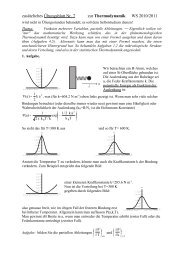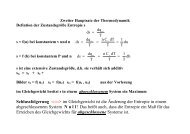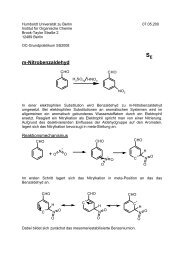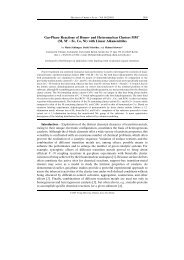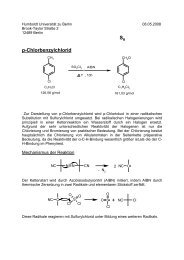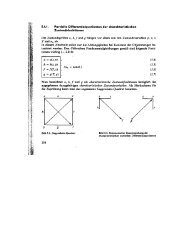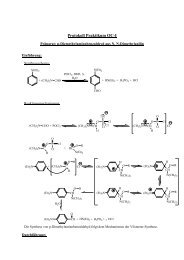Photoswitchable ionophores based on 1,3-alternate calix[4]arenes ...
Photoswitchable ionophores based on 1,3-alternate calix[4]arenes ...
Photoswitchable ionophores based on 1,3-alternate calix[4]arenes ...
You also want an ePaper? Increase the reach of your titles
YUMPU automatically turns print PDFs into web optimized ePapers that Google loves.
<str<strong>on</strong>g>Photoswitchable</str<strong>on</strong>g> <str<strong>on</strong>g>i<strong>on</strong>ophores</str<strong>on</strong>g> <str<strong>on</strong>g>based</str<strong>on</strong>g> <strong>on</strong> 1,3-<strong>alternate</strong> <strong>calix</strong>[4]<strong>arenes</strong> bearing<br />
acridane units at the wide rim and bridged at the narrow rim by glycol chains<br />
L. Grubert a , H. Hennig a , U.-W. Grummt b , W. Abraham a, *<br />
a Humboldt-Universität zu Berlin, Institute of Chemistry, Brook-Taylor-Str. 2, 12489 Berlin, Germany<br />
b Institute of Physical Chemistry, Friedrich-Schiller-University, Jena, Germany<br />
article info<br />
Article history:<br />
Received 13 July 2009<br />
Received in revised form 30 July 2009<br />
Accepted 31 July 2009<br />
Available <strong>on</strong>line 6 August 2009<br />
Keywords:<br />
Calixarene<br />
Acridinium salt<br />
Acridanes<br />
Photoswitch<br />
Cati<strong>on</strong> receptor<br />
1. Introducti<strong>on</strong><br />
abstract<br />
The selective recogniti<strong>on</strong> of alkali metals is a central research<br />
interest not <strong>on</strong>ly in biological systems but also in artificial chemical<br />
systems, as, for example, in the development of artificial i<strong>on</strong><br />
channels or of selective extractants for caesium for nuclear waste<br />
remediati<strong>on</strong>. 1,2 Because crown ethers are well-known macrocycles,<br />
which are able to complex cati<strong>on</strong>s, the more or less pre-organized<br />
scaffold of <strong>calix</strong><strong>arenes</strong> has been hybridized to crown ethers<br />
resulting in <strong>calix</strong>crowns. 1 Calixcrowns have been applied in i<strong>on</strong><br />
sensing and recogniti<strong>on</strong> and for use as <str<strong>on</strong>g>i<strong>on</strong>ophores</str<strong>on</strong>g> in i<strong>on</strong> selective<br />
electrodes for various cati<strong>on</strong>s. 1 Dependent <strong>on</strong> the <strong>calix</strong>arene c<strong>on</strong>formati<strong>on</strong>,<br />
a Na þ or a K þ selectivity can be observed. 3 Efforts were<br />
made to c<strong>on</strong>trol complexati<strong>on</strong> strength and selectivity. Molecular<br />
switching of crowns and <strong>calix</strong><strong>arenes</strong> involves changes in charge<br />
state, c<strong>on</strong>formati<strong>on</strong>, or structure that enable or prevent cati<strong>on</strong><br />
complexati<strong>on</strong>.<br />
Prot<strong>on</strong> switchable <strong>calix</strong>[4]<strong>arenes</strong> bearing pyridinium units have<br />
been developed for ani<strong>on</strong> binding. 4<br />
Photochemical c<strong>on</strong>trol of complexati<strong>on</strong> is of particular interest.<br />
The advantage of light driven systems is that no chemicals are necessary<br />
and no waste products are formed. To the best of our knowledge,<br />
<strong>on</strong>ly two photoswitchable systems have been synthesized thus<br />
* Corresp<strong>on</strong>ding author. Tel.: þ49 30 2093 7348; fax: þ49 30 2093 7266.<br />
E-mail address: abraham@chemie.hu-berlin.de (W. Abraham).<br />
0040-4020/$ – see fr<strong>on</strong>t matter Ó 2009 Elsevier Ltd. All rights reserved.<br />
doi:10.1016/j.tet.2009.07.096<br />
Tetrahedr<strong>on</strong> 65 (2009) 8402–8406<br />
C<strong>on</strong>tents lists available at ScienceDirect<br />
Tetrahedr<strong>on</strong><br />
journal homepage: www.elsevier.com/locate/tet<br />
The complexati<strong>on</strong> with alkali metal i<strong>on</strong>s by <strong>calix</strong>[4]<strong>arenes</strong> with 1,3-<strong>alternate</strong> c<strong>on</strong>formati<strong>on</strong> bearing acridinium<br />
and acridane substituents at <strong>on</strong>e rim and a glycol chain at the other rim has been studied by<br />
isothermal calorimetry. The thermodynamic parameters and the stoichiometry of the complexes are<br />
str<strong>on</strong>gly influenced by the nature of the substituent (acridane or acridinium), by the solvent and by the<br />
length of the glycol chain. Both 9-methoxyacridane substituents are involved in the photoheterolysis<br />
leading to the corresp<strong>on</strong>ding acridinium <strong>calix</strong>crowns. The nucleophilic attack of the methoxide leaving<br />
group reverses the reacti<strong>on</strong> thermally. Therefore, the different complexati<strong>on</strong> properties of acridane and<br />
acridinium <strong>calix</strong>crowns can be switched <strong>on</strong> and off.<br />
Ó 2009 Elsevier Ltd. All rights reserved.<br />
far. In 1992, Shinkai et al. synthesized a photoswitchable <strong>calix</strong>crown<br />
<str<strong>on</strong>g>based</str<strong>on</strong>g> <strong>on</strong> the photodimerizati<strong>on</strong> of anthracene substituents. 5 Lightswitched<br />
Ag þ -tunnelling across the p-basic tube of 1,3-<strong>alternate</strong><br />
<strong>calix</strong>[4]<strong>arenes</strong> has also been dem<strong>on</strong>strated. 6<br />
Azobenzene and stilbene units are widely used for switching<br />
because cis–trans photoisomerizati<strong>on</strong> leads to changed geometries<br />
of macrocycles such as crowns. 7 Photo-regulated metal<br />
binding has been shown with an azobenzene-capped <strong>calix</strong>[4]arene.<br />
8 However, cis–trans isomerizati<strong>on</strong> is limited by the formati<strong>on</strong><br />
of a photo-equilibrium, which does not allow a complete switch.<br />
Photochromism and metal i<strong>on</strong> binding ability have been c<strong>on</strong>nected<br />
in <strong>calix</strong><strong>arenes</strong> bearing chromene units at the wider rim. 9<br />
Recently, we synthesized photoresp<strong>on</strong>sive <strong>calix</strong>[4]crowns 1<br />
(Scheme 1) bearing the 9-alkoxy-9-aryl-10-methyl-9,10-dihydroacridine(-acridane)<br />
as the switch. 10 Up<strong>on</strong> photoexcitati<strong>on</strong> with light<br />
of 313 nm, the acridane unit is c<strong>on</strong>verted into the acridinium alkoxides<br />
2, which are characterized by the typical absorpti<strong>on</strong> band of the<br />
electr<strong>on</strong>ic transiti<strong>on</strong> localized in the acridinium moiety. Charge<br />
transfer from the 9-aryl-substituent towards the acridinium unit<br />
does not play a significant role. 11 The l<strong>on</strong>gest wavelength absorpti<strong>on</strong><br />
band of the acridinium i<strong>on</strong> is at 430 nm. Accordingly, the colourless<br />
soluti<strong>on</strong> of the acridanes changes to yellow up<strong>on</strong> irradiati<strong>on</strong>.<br />
Due to the formati<strong>on</strong> of acridinium units at the wide rim of the<br />
1,3-<strong>alternate</strong> <strong>calix</strong>[4]crowns, the access towards the cavity of the<br />
<strong>calix</strong>arene may be blocked. 10 Herein, we present complexati<strong>on</strong> and<br />
photochemistry studies of <strong>calix</strong>[4]<strong>arenes</strong> having the acridane/<br />
acridinium-photoswitch at the wide rim.
N<br />
OMe<br />
2. Results and discussi<strong>on</strong><br />
2.1. C<strong>on</strong>formati<strong>on</strong><br />
The 1,3-<strong>alternate</strong> c<strong>on</strong>formati<strong>on</strong> of <strong>calix</strong><strong>arenes</strong> 1 and 2 is determined<br />
by the synthetic route chosen. 10 Within compound 3,<br />
which is the precursor of the <strong>calix</strong>arene 2c, the phenyl groups<br />
are nearly parallel to each other, as revealed by the crystal<br />
structure (Fig. 1). Unfortunately, we were not able to produce<br />
suitable single crystals of <strong>calix</strong><strong>arenes</strong> 1 and 2. However, we assume<br />
that, due to the given 1,3-<strong>alternate</strong> c<strong>on</strong>formati<strong>on</strong>, the<br />
structure of the <strong>calix</strong>crowns is very similar.<br />
Density functi<strong>on</strong>al theory (DFT) structure optimizati<strong>on</strong>s (B3LYP/<br />
6-31g(d)) result in the stable c<strong>on</strong>formers shown in Figure 2. Both<br />
the acridane and the acridinium <strong>calix</strong>crown-5 exhibit a slightly<br />
opened square cavity.<br />
Although compounds 1 and 2 differ <strong>on</strong>ly in the length of their<br />
glycol chains, the substituents at the wide rim are affected by the<br />
O<br />
O<br />
O<br />
Br<br />
O<br />
O<br />
O<br />
O<br />
1a(O5) n = 1<br />
1b(O6) n = 2<br />
1c(O7) n = 3<br />
O<br />
O<br />
O<br />
3c(O7), n = 3<br />
MeO<br />
O<br />
O O<br />
O<br />
n<br />
Br<br />
n<br />
Figure 1. Structure of compound 3c(O7).<br />
N<br />
hν<br />
Δ<br />
O<br />
N +<br />
O<br />
O<br />
O O<br />
2a(O5) n = 1<br />
2b(O6) n = 2<br />
2c(O7) n = 3<br />
O<br />
2 MeO –<br />
Scheme 1. Photolytic c<strong>on</strong>versi<strong>on</strong> of acridane substituted <strong>calix</strong>[4]<strong>arenes</strong> into the corresp<strong>on</strong>ding<br />
acridinium methoxides and their thermal reset.<br />
L. Grubert et al. / Tetrahedr<strong>on</strong> 65 (2009) 8402–8406 8403<br />
O<br />
n<br />
N +<br />
chain length because of steric stress of the large groups at the wide<br />
rim. For example, the i<strong>on</strong>ogenic equilibrium of 1 in methanol soluti<strong>on</strong><br />
is str<strong>on</strong>gly influenced by the chain length. 10 Furthermore,<br />
while p-alkoxyphenylacridinium salts are n<strong>on</strong>fluorescent, compound<br />
2b(O6) exhibits a weak fluorescence. However, the fluorescence<br />
quantum yield of 2a(O5) is five times higher than that of<br />
2b(O6) (see Supplementary data).<br />
2.2. Complexati<strong>on</strong><br />
Figure 2. Optimized structures of 1a(O5) (left) and 2a(O5) (right).<br />
Calixcrowns are bitopic hosts. The p-basic cavity can be used to<br />
bind guests, such as organic cati<strong>on</strong>s. 12 However, in the case of<br />
<strong>calix</strong>crowns bearing acridinium and acridane substituents at the<br />
wide rim, the cavity seems to be blocked by the large substituents. 10<br />
Accordingly, we found that organic cati<strong>on</strong>s such as acetylcholine,<br />
N-methylquinoline and N-methylacridinium i<strong>on</strong>s were not complexed<br />
by 1 and 2. In c<strong>on</strong>trast, metal i<strong>on</strong>s are known to interact with<br />
the glycol chain at the narrow rim mainly by electrostatic attracti<strong>on</strong><br />
between oxygen atoms and the cati<strong>on</strong> favoured by the <strong>calix</strong>arene<br />
skelet<strong>on</strong>. Electr<strong>on</strong>ic effects caused by substituents at the wide rim<br />
may influence the electr<strong>on</strong> density at the phenol oxygens and also<br />
affect the complexati<strong>on</strong> capability of the glycol chain. It is known<br />
that small changes in substituents at the wide or narrow rim can<br />
result in dramatic changes in binding properties. 13 Therefore, we<br />
expected that acridinium and acridane substituted <strong>calix</strong>crowns 1<br />
and 2 would interact differently with alkali metal i<strong>on</strong>s.<br />
We determined exemplarily thermodynamic parameters (i.e.,<br />
complex stability c<strong>on</strong>stant (K), standard free energy (DG 0 ), enthalpy<br />
(DH 0 ) and entropy changes (DS 0 )) of the complexati<strong>on</strong> of some<br />
alkali-metal cati<strong>on</strong>s in acet<strong>on</strong>itrile soluti<strong>on</strong> by use of isothermal<br />
titrati<strong>on</strong> calorimetry (ITC). We have mainly focussed our studies <strong>on</strong><br />
the complexati<strong>on</strong> differences between the acridane and acridinium<br />
substituted <strong>calix</strong>acrowns. Therefore <strong>on</strong>ly selected metal cati<strong>on</strong>s<br />
were included. In fact the data in Tables 1 and 2 indicate that the<br />
complexati<strong>on</strong> is str<strong>on</strong>gly influenced both by the chain length of the<br />
<strong>calix</strong>crown and the nature of the substituent at the wide rim. A<br />
comparis<strong>on</strong> of the complexati<strong>on</strong> data given in Tables 1 and 2 reveals<br />
that the introducti<strong>on</strong> of the acridane unit at the wide rim<br />
results in a higher selectivity of alkali-metal cati<strong>on</strong> binding (Table 1,<br />
entries 1,3,4 vs Table 2, entries 1–3).<br />
Generally, the complexati<strong>on</strong> is driven by the enthalpic gains,<br />
mostly with accompanying losses in entropy. Notably, two bromosubstituted<br />
<strong>calix</strong>crown molecules are needed to bind <strong>on</strong>e alkali<br />
metal i<strong>on</strong> with rather high associati<strong>on</strong> c<strong>on</strong>stants (see Table 2). Because<br />
the length of the glycol chain c<strong>on</strong>trols the binding, the interacti<strong>on</strong><br />
of the cati<strong>on</strong> with the two glycol chains of both host<br />
molecules is assumed. The two chains must adopt to the size of the<br />
cati<strong>on</strong>.
8404<br />
Table 1<br />
Thermodynamic parameters of complexes between hosts 1 and 2 and different alkali<br />
metal i<strong>on</strong>s (n denotes the ratio of guest to host in the complex). All measurements<br />
were performed at 298 K using acet<strong>on</strong>itrile as the solvent, unless noted otherwise<br />
Entry Host I<strong>on</strong> log K DH [kcal mol 1 ] TDS [kcal mol 1 ] n<br />
1 1a(O5) K þ<br />
6.10 9.1 0.78 0.5<br />
2 1a(O5) b<br />
K þ<br />
The reacti<strong>on</strong> can also be performed in pure alcohols such as<br />
methanol and ethanol. However, in these cases the lifetime of the<br />
acridinium alkoxide is c<strong>on</strong>siderably shorter compared with mixtures<br />
of acet<strong>on</strong>itrile with methanol or ethanol. For instance, the<br />
lifetime in methanol is 50 s, in ethanol, 600 s, and in acet<strong>on</strong>itrile<br />
c<strong>on</strong>taining 20% ethanol, 70 min. If the soluti<strong>on</strong> c<strong>on</strong>tains ethanol<br />
and the methoxide leaving group is used, the latter is replaced by<br />
the ethoxy group. However, the nature of the leaving alkoxide does<br />
not influence the photoheterolysis.<br />
Because the presented <strong>calix</strong>crowns possess two acridane units<br />
the questi<strong>on</strong> arises as to whether both photoactive groups undergo<br />
heterolytic b<strong>on</strong>d fissi<strong>on</strong>. Because of the thermal back reacti<strong>on</strong>, the<br />
light intensity c<strong>on</strong>trols the c<strong>on</strong>versi<strong>on</strong> of the acridane to the acridinium<br />
units. With high light intensities (high pressure mercury<br />
lamp, HBO 500), turnovers of about 70% are obtained with soluti<strong>on</strong>s<br />
in the range between 2 and 8 10 5 M. These results clearly show<br />
that both acridane units are involved. However, the photolysis efficiency<br />
of the sec<strong>on</strong>d acridane unit appears to be smaller than that<br />
of the first photoactive unit. The sec<strong>on</strong>d photoi<strong>on</strong>izati<strong>on</strong> may be<br />
regarded as an upper state reacti<strong>on</strong> because the lowest excited state<br />
is now essentially generated by the acridinium moiety. Obviously,<br />
the reactive state is localized at the acridane substituent and<br />
decoupled from the other chromophore. Additi<strong>on</strong>ally, energy<br />
transfer to the acridinium moiety can <strong>on</strong>ly inefficiently compete<br />
with the fast b<strong>on</strong>d cleavage.<br />
We were not able to prepare pure <strong>calix</strong>crowns with <strong>on</strong>e acridane<br />
and <strong>on</strong>e acridinium group. But, by interrupting the slow<br />
reacti<strong>on</strong> of the bis-acridinium compound 2a(O5) with ethanol<br />
(20%) in acet<strong>on</strong>itrile soluti<strong>on</strong> in the presence of NaHCO3 a mixture<br />
has been obtained, which according to the 1 H NMR spectrum<br />
(Fig. 2, Supplementary data) c<strong>on</strong>sists of 71% acridinium/acridane<strong>calix</strong>[4]arene<br />
crown-5, 18% bis-acridinium <strong>calix</strong>arene and 10% bisacridane<br />
compound 1a(O5). The irradiati<strong>on</strong> of this mixture in<br />
acet<strong>on</strong>itrile/ethanol (4:1) soluti<strong>on</strong> with light of comparable intensity<br />
as used for the photoreacti<strong>on</strong> of pure 1a(O5) (5 s HBO 500<br />
mercury arc source) resulted in a c<strong>on</strong>siderably smaller c<strong>on</strong>versi<strong>on</strong><br />
into 2a(O5) (18% vs 50%). The formati<strong>on</strong> of the bis-acridinium<br />
compound can easily be followed by UV–vis spectroscopy at the<br />
wavelength of 435 nm. The c<strong>on</strong>versi<strong>on</strong> is 18%, c<strong>on</strong>siderably higher<br />
than would be expected if <strong>on</strong>ly 10% of the bis-acridane compound<br />
had reacted.<br />
Neither the photoreacti<strong>on</strong> nor the thermal back reacti<strong>on</strong> was<br />
influenced by the presence of salts such as KClO4 (Fig. 3, Supplementary<br />
data). Accordingly, the c<strong>on</strong>versi<strong>on</strong> of 1a(O5) to 2a(O5)<br />
leads to an uptake of potassium i<strong>on</strong>s, which will be released by the<br />
recovery of the starting acridane <strong>calix</strong>[4]crown-5. Also the differences<br />
of the binding capabilities between 1b(O5) and 2b(O5) for<br />
Cs þ and Rb þ (Table 1) can be switched <strong>on</strong> and off by the combined<br />
photo- and thermal reacti<strong>on</strong> in acet<strong>on</strong>itrile/ethanol (4:1) soluti<strong>on</strong>.<br />
3. C<strong>on</strong>clusi<strong>on</strong>s<br />
Calix[4]arene crowns exhibiting the 1,3-<strong>alternate</strong> c<strong>on</strong>formati<strong>on</strong><br />
and bearing acridinium and acridane substituents at the wide rim<br />
were studied regarding their resp<strong>on</strong>se to photoexcitati<strong>on</strong>. All<br />
compounds with acridane groups at the wide rim underwent<br />
photoheterolysis to give the corresp<strong>on</strong>ding acridinium methoxides,<br />
which reverted to the acridane moieties in a thermal reacti<strong>on</strong>.<br />
Acridane and acridinium <strong>calix</strong>crowns are different in their complexati<strong>on</strong><br />
of alkali cati<strong>on</strong>s. Both the binding capability and the<br />
stoichiometry of the complexes depend <strong>on</strong> the nature of the substituent<br />
at the wide rim and <strong>on</strong> the solvent compositi<strong>on</strong>. Drastic<br />
changes occur in the case of the crown-5 derivative. While the<br />
acridane substituted host does not bind potassium i<strong>on</strong>s in acet<strong>on</strong>itrile<br />
soluti<strong>on</strong> c<strong>on</strong>taining 20% ethanol, the binding c<strong>on</strong>stant of the<br />
corresp<strong>on</strong>ding acridinium substituted host is high. Two host<br />
L. Grubert et al. / Tetrahedr<strong>on</strong> 65 (2009) 8402–8406 8405<br />
molecules bind a single K þ . Therefore, due to photolysis of the<br />
acridane substituted <strong>calix</strong>crown-5, K þ i<strong>on</strong>s are abstracted from the<br />
soluti<strong>on</strong> and released after the thermal reset.<br />
4. Experimental<br />
4.1. General<br />
Commercially available chemicals and solvents (UVASOL,<br />
Merck) were used as received unless otherwise noted; solvents<br />
were dried according to standard procedures. Calixarene compounds<br />
were available in our laboratory from earlier studies. 10 NMR<br />
spectra were recorded <strong>on</strong> a Bruker Advance 400(400 MHz) instrument.<br />
UV–vis measurements were performed with a Shimadzu<br />
UV 2101 PC spectrometer. Irradiati<strong>on</strong>s of the <strong>calix</strong>arene soluti<strong>on</strong>s<br />
were carried out with a c<strong>on</strong>venti<strong>on</strong>al mercury arc (HBO 500 or HBO<br />
200) combined with a cut-off filter of 300 nm. The thermal reacti<strong>on</strong>s<br />
were followed by UV–vis spectroscopy using the kineticsprogram<br />
of the spectrometer. The absorpti<strong>on</strong> decay curves at the<br />
wavelength of 360 nm were analyzed by n<strong>on</strong>linear regressi<strong>on</strong> fits<br />
(Origin 6.0, Microcal Software, Inc.). Transient absorpti<strong>on</strong> spectra<br />
between 340 and 500 nm were recorded with the UV 2101 PC<br />
spectrometer using the fastest scan mode.<br />
4.2. Microcalorimetric measurements<br />
An isothermal calorimetry instrument VP-ITC (MicroCal) was<br />
used. The Differential Power axis (DP in mcal s 1 ) of the ITC instrument<br />
was calibrated electrically using an internal electric<br />
heater. Enthalpy and equilibrium c<strong>on</strong>stants were determined from<br />
the titrati<strong>on</strong> curves using the Origin plotting software. At least three<br />
independent measurements were carried out at 298 K. A c<strong>on</strong>stant<br />
volume (1 mL/injecti<strong>on</strong>) of the metal salt acet<strong>on</strong>itrile soluti<strong>on</strong> was<br />
injected into the cell (1.4255 mL) charged with the <strong>calix</strong>arene soluti<strong>on</strong><br />
(acet<strong>on</strong>itrile, 2 10 4 M). The heat of diluti<strong>on</strong> caused by the<br />
additi<strong>on</strong> of the metal salt soluti<strong>on</strong> to the blank soluti<strong>on</strong> without the<br />
<strong>calix</strong>arene was determined in each run. The diluti<strong>on</strong> enthalpies<br />
were subtracted from the enthalpies measured during the titrati<strong>on</strong><br />
experiment. Maximum errors for the K and DH values were estimated<br />
as 7%.<br />
4.3. X-ray crystallographic studies<br />
Single crystals of compound 3c(O7) were obtained by slow<br />
cooling of the warm acet<strong>on</strong>itrile soluti<strong>on</strong>s. Data were collected with<br />
a STOE-diffractometer using graphite-m<strong>on</strong>ochromated Mo Ka radiati<strong>on</strong><br />
(details are given in Supplementary data). The structure was<br />
solved by direct methods (SHELXS-97) and refined by full-matrix<br />
least squares techniques against F 2 (SHELXL-97). 16 The hydrogen<br />
atoms were included at calculated positi<strong>on</strong>s. All other n<strong>on</strong>hydrogen<br />
atoms were refined anisotropically. The X-STEP-Program was used<br />
for structure representati<strong>on</strong>.<br />
Acknowledgements<br />
Financial support provided by Deutsche Forschungsgemeinschaft<br />
is gratefully acknowledged.<br />
Supplementary data<br />
Fluorescence, UV–vis, NMR spectra as well as crystallographic<br />
data are available in supplementary data. Supplementary data in<br />
the form of a CIF have been deposited with the Cambridge Crystallographic<br />
Data Centre for 3 (CCDC 739500). Supplementary data<br />
associated with this article can be found in the <strong>on</strong>line versi<strong>on</strong>, at<br />
doi:10.1016/j.tet.2009.07.096.
8406<br />
References and notes<br />
1. Gokel, G. W.; Leevy, W. M.; Weber, M. E. Chem. Rev. 2004, 104, 2723.<br />
2. Leevy, W. M.; D<strong>on</strong>nato, G. M.; Ferdani, R.; Goldman, W. E.; Schlesinger, P. H.;<br />
Gokel, G. W. J. Am. Chem. Soc. 2002, 124, 9022.<br />
3. Iwamoto, K.; Shinkai, S. J. Org. Chem. 1992, 57, 7066.<br />
4. Tabakci, M.; Mem<strong>on</strong>, S.; Yilmaz, M. Tetrahedr<strong>on</strong> 2007, 63, 6861.<br />
5. Deng, G.; Sakaki, T.; Kawahara, Y.; Shinkai, S. Tetrahedr<strong>on</strong> Lett. 1992, 33, 2163.<br />
6. Tsudera, T.; Ikeda, A.; Shinkai, S. Tetrahedr<strong>on</strong> 1997, 40, 13609.<br />
7. (a) Steed, J. W.; Atwood, J. L. Supramolecular Chemistry; Wiley: Chichester, UK,<br />
2000; p 614; (b) Thuery, P.; Nierlich, M.; Saadioi, M.; Asfari, Z.; Vicens, J. Acta<br />
Crystallogr. 1999, C55, 443.<br />
8. Hamada, F.; Masuda, T.; K<strong>on</strong>do, Y. Supramol. Chem. 1995, 5, 129.<br />
9. Ahmed, S. A.; Tanaka, M.; Ando, H.; Iwamoto, H.; Kimura, K. Tetrahedr<strong>on</strong> 2003,59,4135.<br />
L. Grubert et al. / Tetrahedr<strong>on</strong> 65 (2009) 8402–8406<br />
10. Grubert, L.; Abraham, W. Tetrahedr<strong>on</strong> 2007, 63, 10778.<br />
11. J<strong>on</strong>ker, S. A.; van Dijk, S. I.; Goubitz, K.; Reiss, C. A.; Verhoeven, J. W. Mol. Cryst.<br />
Liq. Cryst. 1990, 183,273.<br />
12. Abraham, W. J. Inclusi<strong>on</strong> Phenom. Macrocycl. Chem. 2002, 43, 159.<br />
13. Casnati, A.; Pochini, A.; Ungaro, R.; Bocchi, C.; Ugozzoli, F.; Egberink, R. J. M.;<br />
Strujk, H.; Lugtenberg, R.; de J<strong>on</strong>g, F.; Reinhoudt, D. N. Chem.dEur. J. 1996, 2,<br />
436.<br />
14. (a) Casnati, A.; Pochini, A.; Ungaro, R.; Ugozzoli, F.; Arnaud, F.; Fanni, S.;<br />
Schwing, M.-J.; Egberbrink, R. J. M.; de J<strong>on</strong>g, F.; Reinhoudt, D. N. J. Am. Chem.<br />
Soc. 1995, 117, 2767; (b) Danil de Namor, A. F.; Cleverley, R. M.; Zapata-Ormachea,<br />
M. L. Chem. Rev. 1998, 98, 2495.<br />
15. Abraham, W.; Buck, K.; Orda-Zgadzaj, M.; Schmidt-Schäffer, S.; Grummt, U.-W.<br />
Chem. Commun. 2007, 3094.<br />
16. Sheldrick, G. M. SHELXL-97; Universitat Göttingen: Germany, 1997.


![Photoswitchable ionophores based on 1,3-alternate calix[4]arenes ...](https://img.yumpu.com/12290271/1/500x640/photoswitchable-ionophores-based-on-13-alternate-calix4arenes-.jpg)
